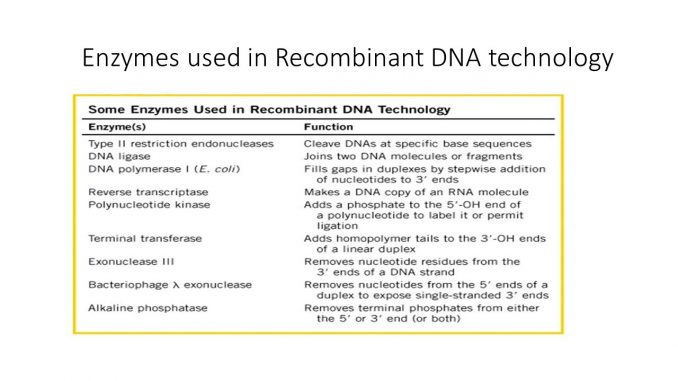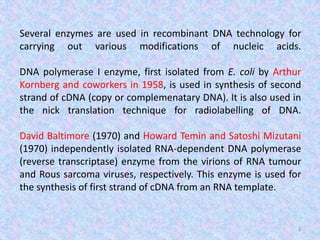Describe Enzymes Used in Genetic Engineering
Genetic engineering became possible with the discovery of mainly two types of enzymes. They recognize and cleave at the restriction sites of the bacteriophage and destroy its DNA.

Enzymes Used In Recombinant Dna Technology Online Biology Notes
Engineered strands produced using renewable sources of biomass are environmentally sustainable and are getting progressively monetarily viable.

. They learn what role enzymes DNA and genes play in the modification of organisms. Drawing on Smiths work American molecular biologist Daniel Nathans helped advance the technique of DNA recombination in 197071 and demonstrated that type II enzymes could be useful in genetic studies. Restriction enzymes are important tools for genetic engineering.
Nucleases Restriction enzymes DNA ligase Kinase Phosphatase Reverse transcriptase Terminal Deoxynucleotide Transferase RNaseP The functions of the various enzymes used in genetic engineering are depicted below. The first major breakthrough on the road to genetic engineering came with work done on restriction endonucleases by Herbert Boyer of the University of California at San Francisco. As a result these transgenic microbes are able to produce and secrete human insulin.
The organism receiving the DNA is said to be genetically. Various enzymes used in genetic engineering are as follows. Cohen and Herbert W.
Genetic engineering also called genetic modification is a process that uses laboratory-based technologies to alter the DNA makeup of an organism. Some of the examples are the green revolution and the white revolution. The main steps of genetic engineering.
Genetic engineering is a technology in which the non desired genes are replaced by the desired genes by either inserting recombinant DNA sequence or by controlled breeding. The nucleotide present on the other side of phosphate is dephosphorylated. Because they cut within the molecule they are often called restriction endonucleases.
This may involve changing a single base pair A-T or C-G deleting a region of DNA or adding a new segment of DNA. For example genetic engineering may involve adding a gene from one. A description of enzymes commonly used in the field of Genetic Engineering.
Humans have used this technology to only develop desired genes where the quality of the breed is enhanced. This is usually a plasmid that. Klenow enzyme is a product of enzymatic breakdown.
An enzyme is a biological catalyst that is usually a protein but could be RNA. Each restriction enzyme cuts DNA at a characteristic recognition site a specific usually palindromic DNA sequence typically between four to six base pairs in length. Restriction enzymes are used to isolate the required gene from the chromosome.
A restriction enzyme or restriction endonuclease is an enzyme that cuts DNA at or near specific recognition nucleotide sequences known as restriction sites. Restriction enzymes are DNA-cutting enzymes found in bacteria and harvested from them for use. As defined by Karl Drlica in Understanding DNA and Gene Cloning.
The restriction enzymes protect the live bacteria from bacteriophages. One example of a transgenic microorganism is the bacterial strain that produces human insulin Figure 1. Both enzymes cleave the phosphodiester bond between adjacent ribonucleotides.
RNase A cleaves next to uracil U and cytosine C in such a way that phosphate remains with these pyrimidines. 20 Enzymes used in Genetic Engineeringpdf - Google Drive. They cut the DNA at a specific sequence.
A vector is needed to get the gene into the host cell. Is the transfer of DNA from one organism to another using biotechnology. Biodegradable engineered polymers incorporate novel strands such as polyglycolic acid and polylactic acid which are.
Boyer who were among the first to cut. Reverse Transcriptase is an enzyme that makes a DNA strand using mRNA that makes a DNA strand using mRNA as a template strand. DNA Polymerase and the Klenow Fragment 5.
Genetic engineering based on recombination was pioneered in 1973 by American biochemists Stanley N. A Guide for the Curious restriction endonucleases are a group of. Describe how bacteria can be used in genetic engineering to produce human insulin Describe the arguments for and against the storage of DNA fingerprints.
The following points highlight the five main enzymes involved in genetic engineering. There Are Various Applications Of The Enzymes In Biotechnology. A restriction enzyme restriction endonuclease is an enzyme that cleaves DNA into fragments at or near specific recognition sites within molecules known as restriction sites.
And there are many many enzymes that are encoded by the genome to make proteins or RNAs that speed up various chemical reactions to do thousands of different functions inside a cell. It is also known as RNA dependent DNA synthetase. A palindrome is a sequence of letters that reads the same.
Today we use restriction enzymes extensively for cutting DNA fragments that can then be spliced into another DNA molecule to form recombinant molecules. The insulin gene from humans was inserted into a plasmid. This recombinant DNA plasmid was then inserted into bacteria.
The point of a catalyst is to increase the speed with which a reaction happens. Virtually all plasmids that are used to deliver DNA contain genes for. They can be isolated from the.
Generally RNase A and RNase T1 enzymes are used in genetic engineering techniques. The cutting enzymes called. Restriction Enzymes and Plasmids.
In the bacterial cell restriction enzymes cleave foreign DNA thus eliminating infecting organisms.

Gene Therapy Uses Safety Ethics Concerns Uses Genetic Engineering Technique Making Insulin Pros Cons Gm Crops Products Medical Applications Dna Ligase Restriction Enzymes Igcse O Level Gcse 9 1 Biology Revision Notes Examinations

Enzymes Used In Recombinant Dna Technology Online Biology Notes


No comments for "Describe Enzymes Used in Genetic Engineering"
Post a Comment